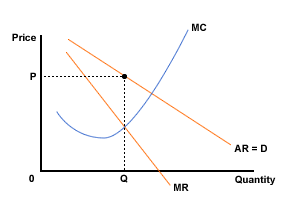Forms of collusion
Formal collusion
The most common type of formal collusion is through the cartel; where a small number of rival firms, selling a similar product, come to the conclusion that it is in their joint interests to formally collude rather than compete, they may establish a cartel arrangement in which they agree to set an industry price and output which enables them to achieve a common objective. This is likely to involve the setting of agreed output quotas for each member in order to maintain the agreed price.
A successful cartel arrangement, from the point of view of the participating firms, would be one in which the cartel acts like a single monopolist to maximise profits of individual members. This is illustrated in figure 1 below.

Figure 1 Profit maximisation for the cartel
This is the familiar monopoly diagram, with each curve representing the aggregated situation for all the firms in the cartel. In order to maximise profits, MC is equated with MR and a price of OP is set, with an output of OQ, which represents the potential level of sales. The allocation of this market quota between members could be decided by such criteria as geography, productive capacity or pre-cartel market share, or cartel members, having set a price of OP, could engage in non-price competition to each gain as large a slice of OQ as they can.
In practice, cartels may tend to be rather fragile and may not last for very long. This is because individual members may have an incentive to renege on the agreement by secretly undercutting the cartel price. The almost inevitable necessity to limit output to keep price high will tend to leave individual firms with spare productive capacity, and provide the temptation to increase profits by expanding output. Such an expansion would not only generate profit on the additional sales, but would also increase the profits on existing sales, as average fixed costs would fall as output expanded.
As the end result of successful collusion will be to create a situation similar to monopoly, with its consequent drawbacks and loss of economic efficiency, cartels are illegal in many countries, including the UK and the USA. Various cartels do, however, operate internationally, the most famous of which is OPEC, referred to earlier in your studies. Another example of an international cartel is IATA (The International Air Transport Association) which has sought to set prices for international airline routes. However, the experience of both these cartels has been one of price cutting amongst its members, particularly during periods of declining product demand and competition from non-members.
Informal or tacit collusion
The most usual method of tacit collusion is priceleadership. This occurs where one firm sets a price that is subsequently accepted as the market price by the other producers. There need be no formal or written agreement for this to happen; it is sufficient that firms believe this to be the best way of maintaining or increasing their profits. An example of price leadership is provided by the Ford Motor Company who has often been the first to raise prices in the car industry.

Activity
Choose a particular market to study, e.g. the market for soap powders, chocolate bars, computers, ice cream or any other of your choice.
Investigate the degree and nature of competition in your chosen market and the implications of this for producers and consumers.
